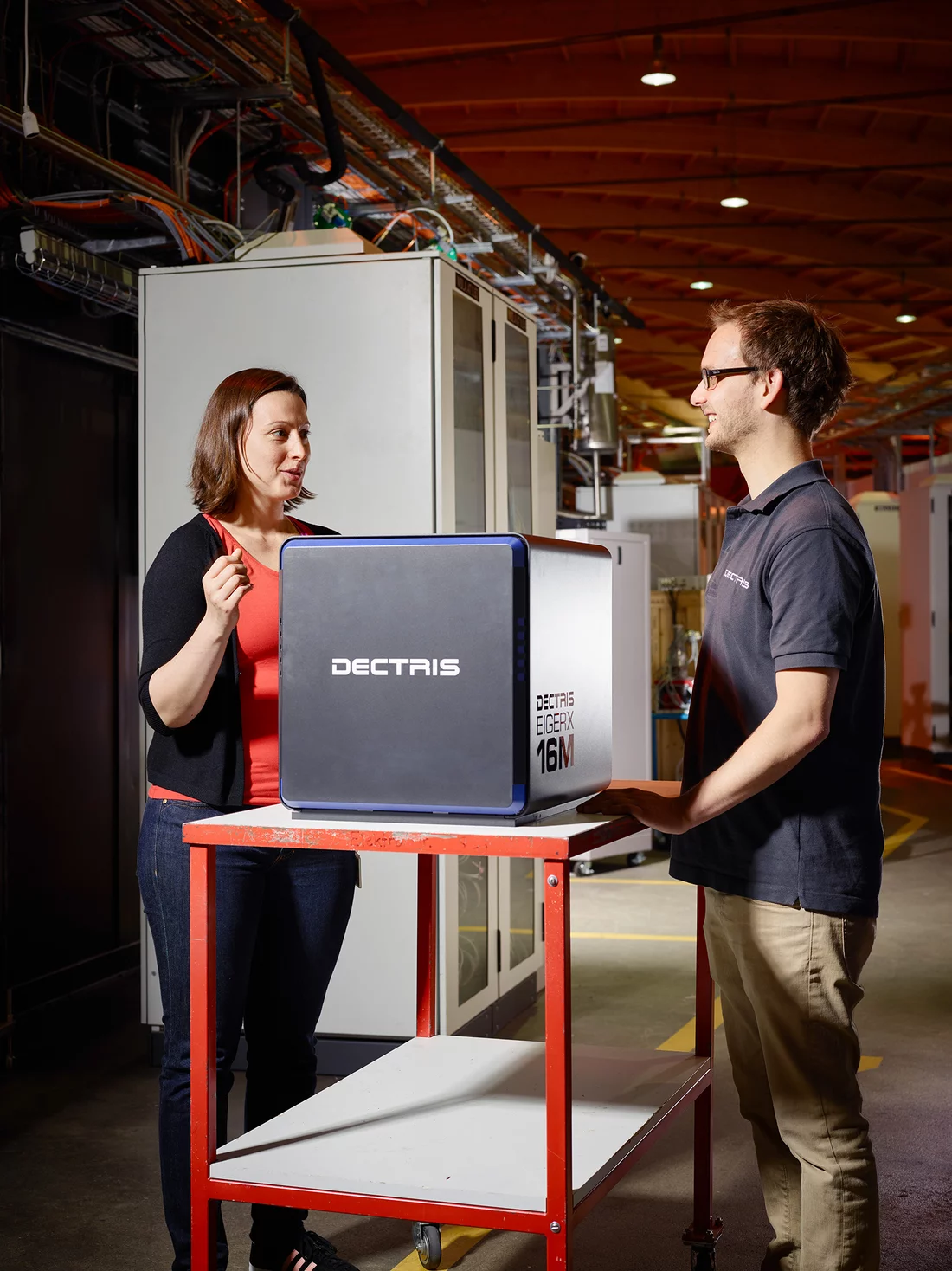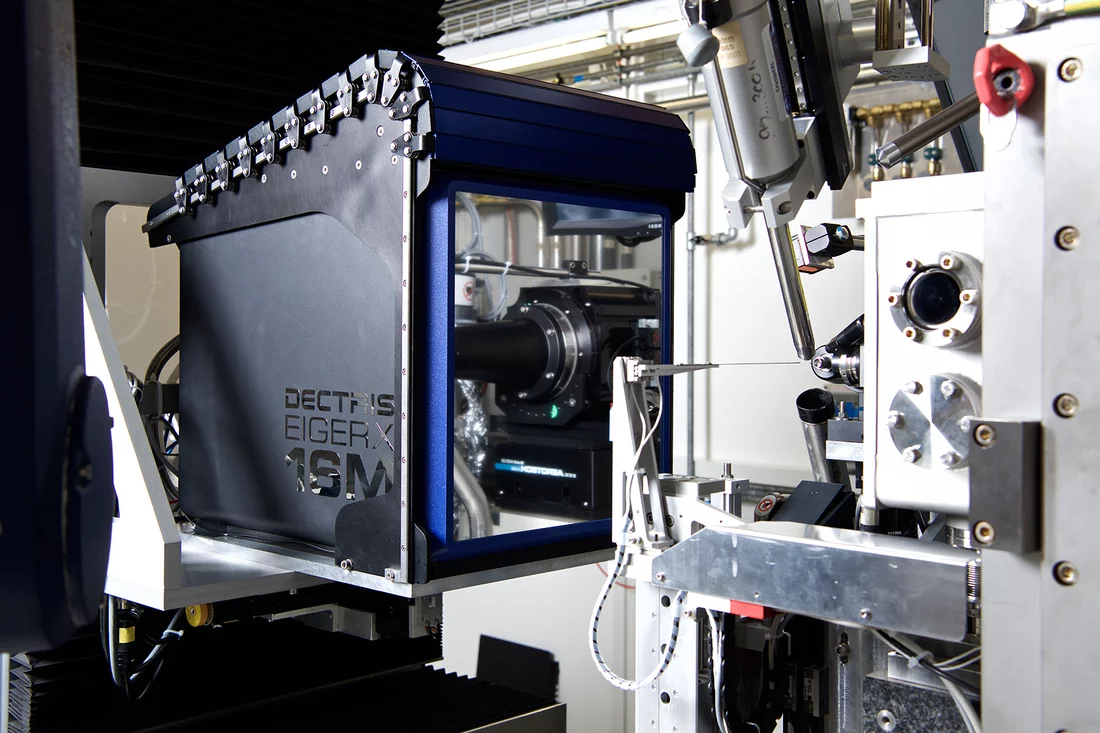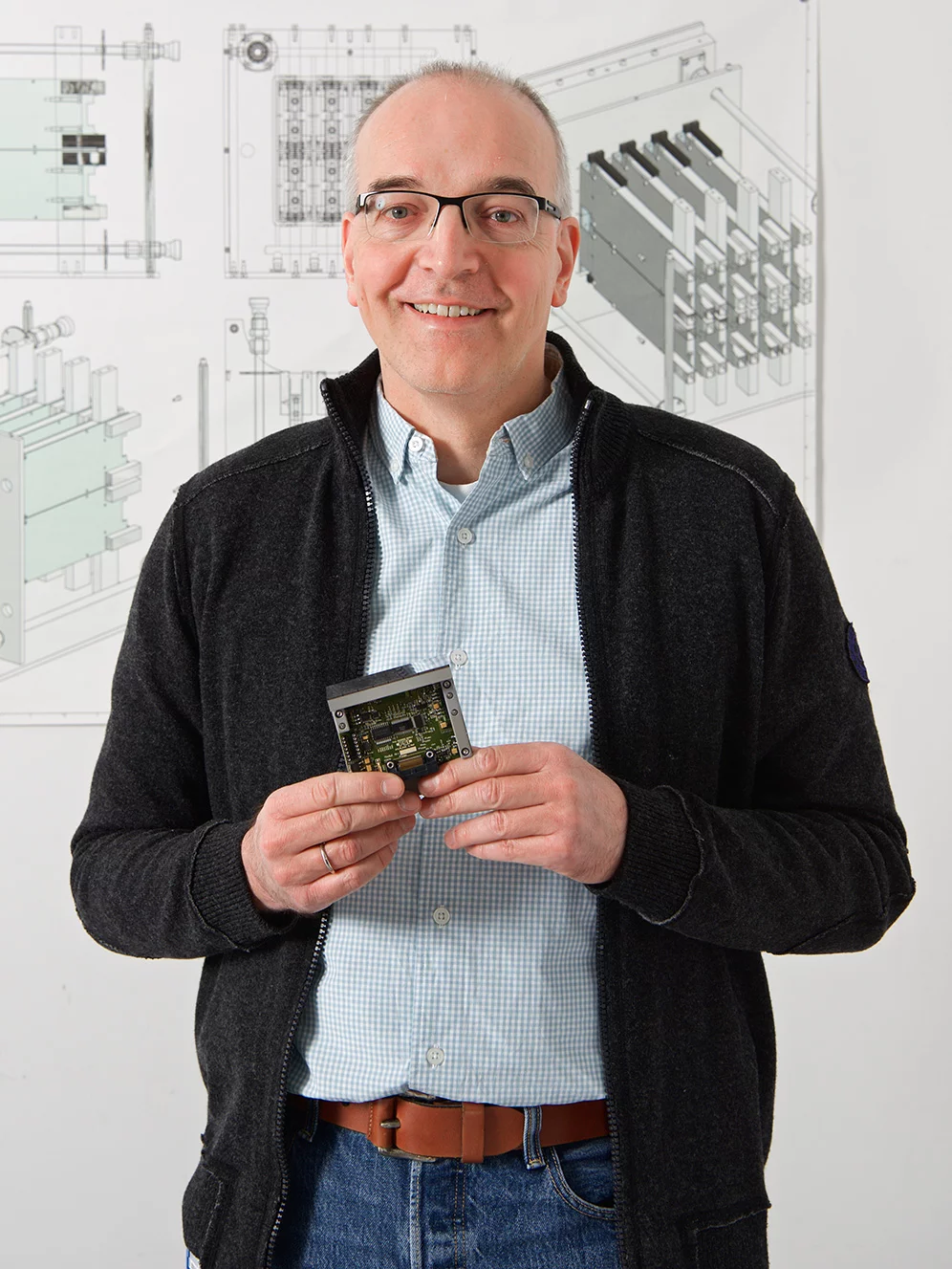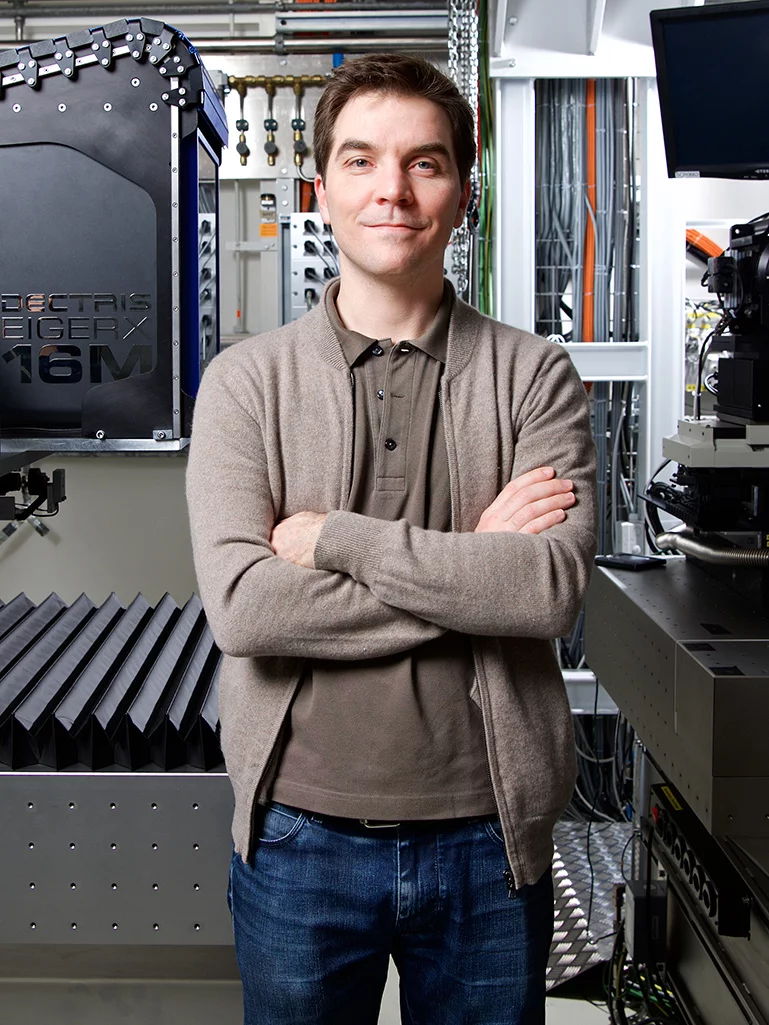New ultrafast detector at the Paul Scherrer Institute
A picture-perfect example of how basic research makes solid contributions to the economy is the company DECTRIS in Baden-Dättwil, Switzerland — a spin-off of the Paul Scherrer Institute PSI, founded in 2006 and already highly successful. The detector that became, around ten years ago, the company’s founding product originated in the course of the search for the Higgs boson. Now the newest development from DECTRIS is on the market: an especially precise detector called EIGER, which is used for X-ray measurements at large research facilities. Since the fall of 2015, the newest model of the EIGER series has proven itself at the Swiss Light Source SLS. These days, researchers are writing the first scientific publications about experiments that have been carried out with the new detector. EIGER helps researchers to measure protein molecules better and more precisely than before. That in turn is of great interest for the development of new pharmaceuticals. It’s possible that urgently needed alternatives to antibiotics might be found in this way.
The device which now is making work easier for researchers in drug development among other areas is called EIGER. It could be described as a type of high-speed X-ray camera. Strictly speaking, EIGER is a detector that allows measurements with X-rays at large research facilities. The device is a new development of the company DECTRIS, based in Baden-Dättwil, Switzerland, and the Paul Scherrer Institute PSI.
When it comes to detector development, the EIGER series sets new standards. The distinctive features of this detector are both a high number of pixels — comparable to the pixels of a digital camera — and enormously fast image processing. The fastest version of the EIGER can capture up to 3000 images per second. With that the detector generates roughly the amount of data that fits on a DVD every second.
The version of EIGER with the most pixels, 16 million in all, is accordingly named the EIGER X 16M. The very first EIGER X 16M went into service on 14 October 2015 in the crystallography laboratory of the Swiss Light Source SLS of the PSI. Now researchers are writing the first scientific publications about experiments that have been carried out with the new detector. That closes a circle, since the company DECTRIS itself came out of research and development at the PSI around ten years earlier.
For the search for the Higgs boson at CERN
It all began in the mid-1990s: The PSI was assigned the task of developing a new type of detector for CERN and its search for the Higgs boson — which in the meantime has been discovered. PSI physicist Roland Horisberger got down to work. Over the course of 12 years, he and his co-workers developed a novel pixel detector that would be capable of handling the high particle counts at CERN.
In the process, the PSI researchers had gained a competence that they could also put to use for their own institute: They adapted the new detector type in such a way that it could capture not only particles, but also the X-rays of the Swiss Light Source SLS. The researchers named the resulting X-ray detector PILATUS. “The development of PILATUS was an enormous opportunity for the PSI and complemented the SLS, still very young at the time, perfectly,” says Bernd Schmitt, who today leads the research group for detector development at the SLS. Even before the original version of the detector went into service at CERN, PILATUS detectors at the PSI were already delivering valuable data.
From fundamental research to a successful business
The PILATUS detector soon aroused worldwide interest among researchers. In order to transform it into a market-ready product, the developers founded the company DECTRIS in 2006 as a spin-off of the PSI. Since the early days with only a handful of co-workers, DECTRIS has grown into a substantial Swiss enterprise with around 80 employees.
To this day, DECTRIS collaborates closely with the PSI. The microchip at the heart of the EIGER detector was also originally developed at the PSI — likewise, by researchers associated with Roland Horisberger. “On this basis, DECTRIS produced the complete detector within just a few years,” Horisberger says appreciatively.
Early on, the Swiss Commission for Technology and Innovation (CTI) already recognized the potential of the partnership between the PSI and DECTRIS and promoted development of the EIGER detector to a finished product. During this phase, EIGER was tested intensively on actual experiments at the SLS. Ultimately, the world’s first EIGER X 16M detector went into operation at the crystallography laboratory of the SLS.
Probing protein structures helps in the development of new drugs
In the crystallography laboratory researchers of the PSI, visiting scientists and, not least, researchers working on behalf of industry are determining the structure of a wide range of different proteins. Proteins are complex biological molecules in the cells of our bodies; they are also known as the building blocks of life. Each type of protein has a specific role to play in the organism. Proteins consist of thousands of atoms ordered in many-layered arrangements. The complex structure of the proteins determines their respective modes of operation in the body and is therefore of great interest to researchers. The pharmaceutical industry, for one, is interested in the structure of crucial proteins to enable the development of medicines custom-designed to act only on these very specific proteins.
For example, one current strategy aims at blocking a protein that duplicates the DNA of bacteria. This bacterial protein, in fact, strongly resembles the corresponding human protein. Yet if the subtle differences are known in detail, it should be possible to develop a compound that only interferes with the bacterial protein.
The exact structure of the proteins, however, is very difficult to determine because of their complexity. A commonly used method is X-ray crystallography. For this purpose, micrometer-sized crystals are first grown from many exemplars of the protein to be studied. These can then be probed with a very fine and very intense X-ray beam. The SLS is among the few facilities worldwide that can deliver such a beam. With this method, scientists can determine the arrangement of the atoms and thus the structure of the protein under investigation. Researchers at the SLS have been able to decipher the structure of around 4000 different proteins over the past ten years. That places the SLS among the most productive facilities of its kind in the world.
Fast images and hundreds of crystals
Yet already in the process of crystal growth, challenges are lurking. “Often, hundreds of crystals must be grown and examined in order to have one that will yield a sharp, usable X-ray diffraction image,” explains Vincent Olieric, a scientist in the SLS crystallography laboratory. First, to be able to measure all of these crystals in a reasonable amount of time, the transition between the individual samples must be very fast. “Doing it by hand would take too long,” Olieric explains: “So in our lab a robot arm exchanges one crystal for the next — and does it in under one minute.”
Second, the measurement time for each individual sample must be short. Here the researchers profit from EIGER’s extremely rapid image processing. “The complete measurement of each individual crystal lasts just a few minutes,” Olieric says.
Thus the speed of the EIGER gives researchers a real chance to find the one usable crystal among many and thus to decipher the structure of even the most complex proteins. In this way, EIGER could one day help point the way to new pharmaceuticals, including alternatives to antibiotics — a research area of central importance in the age of increasing antibiotic resistance.
Text: Paul Scherrer Institute/Laura Hennemann
About PSI
The Paul Scherrer Institute PSI develops, builds and operates large, complex research facilities and makes them available to the national and international research community. The institute's own key research priorities are in the fields of matter and materials, energy and environment and human health. PSI is committed to the training of future generations. Therefore about one quarter of our staff are post-docs, post-graduates or apprentices. Altogether PSI employs 1900 people, thus being the largest research institute in Switzerland. The annual budget amounts to approximately CHF 380 million. PSI is part of the ETH Domain, with the other members being the two Swiss Federal Institutes of Technology, ETH Zurich and EPFL Lausanne, as well as Eawag (Swiss Federal Institute of Aquatic Science and Technology), Empa (Swiss Federal Laboratories for Materials Science and Technology) and WSL (Swiss Federal Institute for Forest, Snow and Landscape Research).
About DECTRIS
DECTRIS is the technology leader in X-Ray detection. The DECTRIS photon counting detectors have transformed basic research at synchrotron light sources, as well as in the laboratory and with industrial X-Ray applications. DECTRIS aims to continuously improve the measurement quality, thereby enabling new scientific findings. This pioneering technology is the basis of a broad range of products, all scaled to meet the needs of various applications. DECTRIS also provides solutions for customer developments in scientific and industrial X-Ray detection. DECTRIS was awarded the 2010 Swiss Economic Award in the High-Tech Biotech category, the most prestigious prize for start-up companies in Switzerland.
Further information
Press release on EIGER X 16MShort profile of the company DECTRIS
Webseite of the company DECTRIS
Contact
Dr. Oliver Bunk, Head of Laboratory for Macromolecules and Bioimaging, Paul Scherrer InstituteTelephone: +41 56 310 30 77, e-mail: oliver.bunk@psi.ch (German, English)
Dr. Vincent Olieric, Laboratory for Macromolecules and Bioimaging, Paul Scherrer Institute
Telephone: +41 56 310 52 33, e-mail: vincent.olieric@psi.ch (English, French)
Prof. Roland Horisberger, Group Leader High Energy Physics, Paul Scherrer Institute
Telephone: +41 56 310 32 06, e-mail: roland.horisberger@psi.ch (German, English)
Dr. Bernd Schmitt, Group Leader Detector Development, Paul Scherrer Institute
Telephone: +41 56 310 23 14, e-mail: bernd.schmitt@psi.ch (German, English)
Dr. Andreas Förster, Application Scientist Macromolecular Crystallography, DECTRIS
Telephone: +41 56 500 21 76, e-mail: andreas.foerster@dectris.com (German, English)






